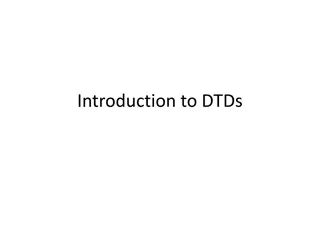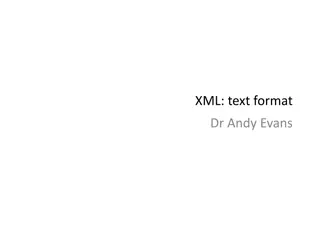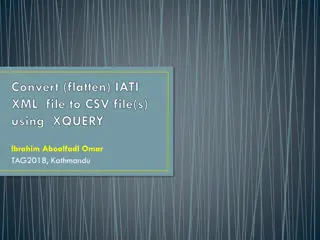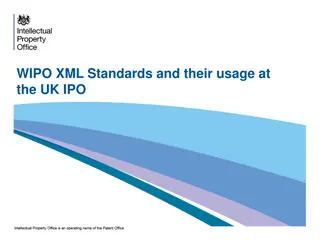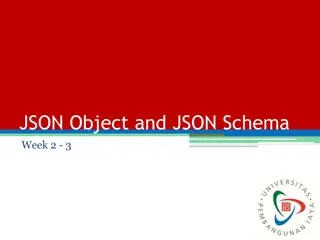
Here are the details based on the provided content: "Understanding AJAX, JSON, XML: Asynchronous Web Development Techniques
Discover how AJAX, JSON, and XML revolutionize web development through asynchronous data retrieval, simplified data formats, and streamlined user experiences. Explore the differences, common uses, and benefits of each technology.
Download Presentation

Please find below an Image/Link to download the presentation.
The content on the website is provided AS IS for your information and personal use only. It may not be sold, licensed, or shared on other websites without obtaining consent from the author. If you encounter any issues during the download, it is possible that the publisher has removed the file from their server.
You are allowed to download the files provided on this website for personal or commercial use, subject to the condition that they are used lawfully. All files are the property of their respective owners.
The content on the website is provided AS IS for your information and personal use only. It may not be sold, licensed, or shared on other websites without obtaining consent from the author.
E N D
Presentation Transcript
AJAX, XML AND JSON with thanks to Rob McMahon
AJAX Asynchronous JavaScript and XML Synchronous Events stop any other events from happening before completion Asynchronous Events can happen regardless of any other events that are in progress The most common use of this in web development happens when loading data onto a page without reloading the page as a whole. Examples include: File transfers / loading data Adding items to a cart Dynamic search bar results
AJAX Common data formats received from AJAX requests include JSON, XML, and HTML The process of retrieving information asynchronously involves three major steps: The browser requests information from the server The server responds with data (JSON, XML or HTML) The browser processes the information and adds it to the page This means that the user is able to do other things while an AJAX request is completed Thus, UIX (user interface experience) can be sped up
JSON JavaScript Object Notation Used as an alternative to XML Minimal, readable format for structured data Normally grouped into dictionaries of objects with the same properties Also includes lists as containers Limited data types: strings, integers, Booleans
XML Similar to JSON format with a few key differences Provides the ability to display data since it is a markup language XML supports many data types (ex. strings, integers, images, charts) Tags can be any word (just not xml) XML is supported by many more desktop applications than JSON
JSON VS. XML JSON XML Less verbose / easy to read Supported by many more desktop Faster parsing applications / platforms Objects align in code AJAX includes XML in it, not JSON Commonly used with JavaScript Easily converted to XHTML Unforgiving syntax, missed comma can break file Flexible data format, can be converted to complex structures
HTML The Bad Not well-suited for anything other than web- The Good The third common format that an AJAX request will respond with applications Server must produce formatted HTML that is Easy to write, request and display on webpages ready to use Requests must come from the same domain Simplest way to update a section of a webpage (ex. cannot access an API from another source)
USING AJAX Web development requires a range of languages and technologies AJAX requests are written in JavaScript, though implementation requires more Specifically, AJAX requests require a server-side scripting language (PHP, Node.js, Perl, Ruby, Python, etc.) This allows for communication between the server and browser jQuery, (a JavaScript framework), can make AJAX much easier to use with its built-in functionality Specifically, requests and processing data after requests
AJAX REQUESTS, WITHOUT JQUERY var xmlHttp = new XMLHttpRequest(); //creates a new instance of XMLHttpRequest object xmlHttp.open( GET , data.json , true); //Prepare the Request! //http method, url to handle info //Boolean asynchronous? xmlHttp.send(null); //Send the request, parameter can be any additional info
AJAX RESPONSES, WITHOUT JQUERY xmlHttp.onload(function () { if (xmlHttp.status == 200) { //Ensure that the response was not corrupted //process the results from the server } });
AJAX, WITHOUT JQUERY jQuery makes it much easier to process data when utilizing AJAX It is much more difficult to access / display specific data without using jQuery Here is an example from the textbook
DYNAMIC SEARCH BAR EXAMPLE The languages used to create this example include HTML, CSS, JavaScript / jQuery, PHP, and SQL. Step 1: create database and users table id, first_name, last_name Created with MySQL
BASE HTML / CONNECT TO DB
EXAMPLE CONT. SCRIPT.JS FILE, USING JQUERY / AJAX
SEARCH.PHP FILE Example of processing data in HTML format Must be done within server-side file Query to database, echo results to browser
RESULT Allows for dynamic search bar without reloading entire webpage Asynchronous, on the fly functionality
WHAT WAS REQUIRED? The browser requested information from the server when any key was pressed (script.js file) Used AJAX to run PHP script, using url property The PHP query script is fired upon the AJAX request, scanning the database for any potential last-name matches The browser processes the formatted HTML response received from the database in the PHP query script.
MORE JSON & XML Example from Industry


